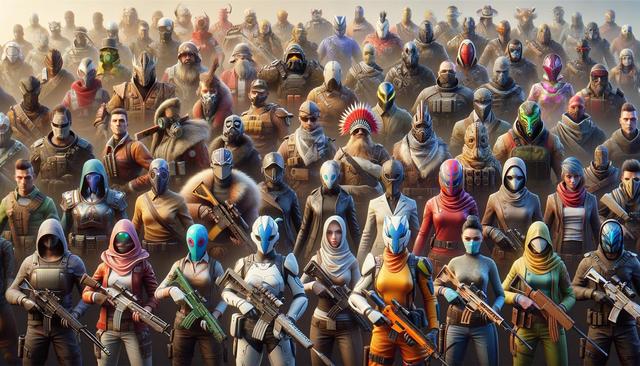The Role of Game Skins in Modern Gaming
Game skins, also known as cosmetic customizations, have become a central part of the gaming experience across genres and platforms. These visual alterations allow players to personalize their characters, weapons, vehicles, and environments without affecting gameplay mechanics. Skins serve as a form of self-expression and help players feel more immersed in virtual worlds. Whether it’s a fantasy-themed outfit or a futuristic armor set, game skins contribute to the identity and storytelling of the player within the game universe. As gaming communities grow more diverse, the demand for personalized content—such as custom avatars and skins—continues to rise.
Gamers are increasingly seeking ways to make their digital personas stand out. This has led to a surge in interest in creating unique in-game appearances, often tied to seasonal events, fandoms, or player achievements. Game developers recognize this trend and frequently introduce limited-edition or collectible skins to cater to their audience’s preferences. The ability to design or modify these skins is no longer restricted to professionals; thanks to UI and UX tools, players can now learn how to create their own through various online resources, including Custom Avatars and Design Courses.
Designing Skins: A Creative Process
The process of designing game skins involves a blend of artistic creativity, technical understanding, and user interface knowledge. Skins need to reflect not just visual appeal but also functionality and compatibility with the game’s environment. When creating custom avatars or character designs, artists must consider color theory, texture mapping, and animation integration. These elements ensure that the skin looks appealing while maintaining performance across devices and platforms.
Many aspiring designers turn to online learning platforms to master these skills. Custom Avatars and Design Courses provide structured content on topics such as:
- Digital illustration and concept art for games
- User Interface (UI) design for character customization tools
- User Experience (UX) strategies to enhance player satisfaction
- 3D modeling and texturing for avatars and accessories
These courses often include hands-on projects, enabling learners to develop a portfolio of skins and avatars that can be used in real-world applications or showcased in design communities.
The Impact of UI and UX in Skin Customization
User Interface (UI) and User Experience (UX) design play a significant role in how players interact with skin customization tools within games. A well-designed interface makes it easier for users to create, apply, and manage their skins without confusion or frustration. UX design focuses on ensuring that the customization process is intuitive, engaging, and rewarding. This might include drag-and-drop features, color palette options, and real-time previews.
Developers and designers working on customization features must understand how players think and behave in digital environments. Enrolling in Custom Avatars and Design Courses equips learners with the skills to design interfaces that are not only functional but also enjoyable to use. These skills are especially valuable in multiplayer or online games, where personalization plays a key role in community interaction and player retention.
Monetization and Ethical Considerations
As skins become more integral to the gaming economy, many developers monetize them through microtransactions or subscription models. While this presents opportunities for artists and game studios, it also raises questions about accessibility and fairness. Players who cannot afford premium skins may feel left out, leading to a divide within the gaming community. Ethical game design encourages balanced approaches that offer both free and paid customization options.
Custom Avatars and Design Courses often incorporate discussions on ethical design practices, teaching students how to create inclusive content that respects diverse user needs. Designers learn to develop avatar systems that accommodate different body types, cultures, and identities, making gaming more welcoming and representative. This inclusive mindset is becoming increasingly important, especially as games reach global audiences.
From Player to Creator: Opportunities in Game Skin Design
Learning how to design game skins and avatars can open up professional and creative opportunities. With the rise of user-generated content platforms and modding communities, players are transitioning into creators, contributing to games they love. Skills acquired through Custom Avatars and Design Courses enable enthusiasts to build and share their own designs, potentially leading to freelance work, collaborations with indie developers, or full-time careers in game design.
Some of the potential paths for those skilled in skin and avatar design include:
- Freelance skin designer for indie or mobile games
- In-house artist at a game development studio
- UI/UX designer specializing in customization systems
- Content creator producing tutorials or digital assets
These roles require a combination of technical proficiency and creative vision, both of which are emphasized in comprehensive Custom Avatars and Design Courses. With ongoing developments in virtual and augmented reality, the importance of personalized digital identities is only expected to grow.
Conclusion: Empowering Creativity in the Virtual World
Game skins have transformed from simple cosmetic features to powerful tools for creative expression, identity, and community engagement in gaming. Whether you’re a casual player wanting to personalize your character or an aspiring designer aiming to make a mark in the industry, learning how to create custom avatars and skins can be both fulfilling and professionally rewarding.
Enrolling in Custom Avatars and Design Courses provides the foundational skills needed to navigate this exciting space. From understanding user interface design to mastering digital art techniques, these courses prepare learners to contribute meaningfully to the evolving world of interactive entertainment. As personalization becomes more central to digital experiences, the ability to design compelling, inclusive, and user-friendly skins will remain a valuable asset in the gaming and tech industries.
